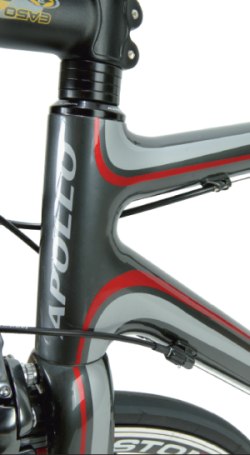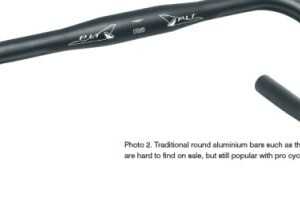For more than 25 years Apollo bicycles have been available to Australian consumers. In that time the Apollo brand has been very successful in its market focus of providing quality, well priced bikes for the general public. Until recently their competition range in both Road and MTB was branded under the Raceline logo, but for 2008 the Apollo brand will once again be used for all the Raceline Series range. The Apollo Ultra C is ranked number two in the Raceline Series range and comes with a carbon frame and fork for a very well priced $2,899. It shares the same frame with lower priced models Vispo ($2,499) and Giro ($1,999) while the top of the line Elite C with Shimano Dura-Ace comes with a different design of frame at $4,999. These prices are very competitive, but there is little sign of a drop in quality in either the design or specifications throughout the range. I remember my time working at a bike shop as a teenager during the pre Christmas rushes and building up bikes from various manufacturers out of the box. A lot can be determined about the quality of a bike in how easily it builds up, and how much attention is given to the packing and the set up of various pre-installed parts. The Apollo’s always came in the best un-crumpled boxes and were always a pleasure to build with very little adjustment needed.
The graphic design of Apollo has always been clean and stylish and the 2008 range remains just that. The Ultra C comes in charcoal grey with silver and red pin striping and the Apollo brand extending down the seat tube. It’s a refreshing change for a carbon bike to be fully painted with the only sign of carbon weave on the seat post. It may in some ways belie its carbon nature, but a flick of the finger against the down tube will give away its secret.
I was very impressed with the clean lines of this bike, especially so around the head tube. The main triangle tube shapes are traditionally rounded, but the top tube is flattened as it moulds its way around the seat tube to form the kinked wishbone seat stay. The only deviation from the round is in the box shaped chain stays. Out on the road the ride was very smooth and the steering precise and well balanced. At 8.2 kilograms with pedals, the weight in this price range is quite respectable. Combined with good stiffness the relatively low weight made this bike a pleasure to climb with. The frame provided a solid platform to get the power down, but also felt comfortable enough on the rougher roads.
 The frame comes in five frame sizes and the seat and heat tube angles remain the same throughout the range. This is one area where a cost saving can be made by the manufacturer as the number of specific moulds required is reduced. The downside is that there is a certain compromise in the available sizes and certain issues that arise, particularly in the smaller sizes. We tested the 53 cm frame and dimensions in this size were fine, but in the smaller 50 cm size it is somewhat of a surprise to see a 74 degree head angle. Most small frames have a shallower head angle coupled with more fork rake to help move the front wheel away from the pedals and eliminate the annoying overlap. Apollo goes some way in alleviating this by using a relatively long top tube, but this solution can make fitting smaller riders a bit hard. Most of the Ultra C’s components are Shimano Ultegra. The gears and brakes work faultlessly and without complaint. I can never tell the difference in performance between Ultegra and my own Dura- Ace equipped bike. The bars and stem are from Easton with the bars being anatomic in design. While the straight section on the drops is comfortable enough, it makes reaching the brakes in that position nearly impossible without jamming your hand into the tight curve. There are a couple of deviations from a fully equipped Ultegra specification which also helps keep the price down. There is a Shimano 105 front derailleur, cassette and chain, which don’t really limit performance too much. Unfortunately there is no Shimano Hollowtech crankset on offer. The Truative crankset performed the job admirably, but looks a bit dull. I normally prefer a set back seat post, but with a 73.5 degree seat angle (on all frame sizes) it didn’t prove to be too much of an issue to set up my position behind the bottom bracket.
The frame comes in five frame sizes and the seat and heat tube angles remain the same throughout the range. This is one area where a cost saving can be made by the manufacturer as the number of specific moulds required is reduced. The downside is that there is a certain compromise in the available sizes and certain issues that arise, particularly in the smaller sizes. We tested the 53 cm frame and dimensions in this size were fine, but in the smaller 50 cm size it is somewhat of a surprise to see a 74 degree head angle. Most small frames have a shallower head angle coupled with more fork rake to help move the front wheel away from the pedals and eliminate the annoying overlap. Apollo goes some way in alleviating this by using a relatively long top tube, but this solution can make fitting smaller riders a bit hard. Most of the Ultra C’s components are Shimano Ultegra. The gears and brakes work faultlessly and without complaint. I can never tell the difference in performance between Ultegra and my own Dura- Ace equipped bike. The bars and stem are from Easton with the bars being anatomic in design. While the straight section on the drops is comfortable enough, it makes reaching the brakes in that position nearly impossible without jamming your hand into the tight curve. There are a couple of deviations from a fully equipped Ultegra specification which also helps keep the price down. There is a Shimano 105 front derailleur, cassette and chain, which don’t really limit performance too much. Unfortunately there is no Shimano Hollowtech crankset on offer. The Truative crankset performed the job admirably, but looks a bit dull. I normally prefer a set back seat post, but with a 73.5 degree seat angle (on all frame sizes) it didn’t prove to be too much of an issue to set up my position behind the bottom bracket.
I must admit that when I first looked at the Prologo saddle with its hard plastic trim, masochistic perforations and firm feel, I wasn’t looking forward to sitting on it for any extended period. It certainly looked cool, and probably wouldn’t look out of place on Darth Vader’s Tie fighter, but it just didn’t look comfortable. Surprisingly it wasn’t too bad and I soon forgot it was there.
The Easton Circuit wheelset proved to be a solid performer. They come in at a respectable weight of 1,650 grams for the pair. They combine a 28 mm deep alloy rim with a very attractive pair of hubs using double butted stainless spokes, 24 in the front and 28 in the rear. The machined breaking surface provided good consistent braking and the wheels felt stiff and solid in all conditions. The wheels are shod with Michelin Lithion tyres. It’s the first time I’ve used this model, but I have been using their more expensive relative, the Pro Race 2. The grip levels compare equally well, and although there is a slight weight penalty and stiffer casing, the road feel is still very good indeed. If they keep wearing as well as they seem to be, then these come highly recommended. Overall I was very impressed with the Ultra C and it bodes well for Apollo’s return to the high end racing market. The bike performed its function of a light weight racing machine without fault. There are some limitations in the frame design that may limit the fit for smaller riders preferring a shorter top tube, but overall the ride quality of the size tested was excellent.

